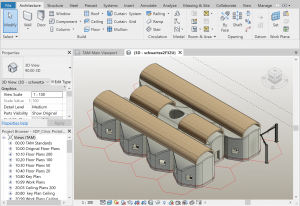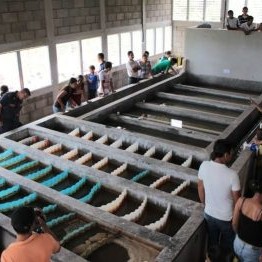3D printing technology has begun to revolutionize the way we can think about developing the built environment in resource-scarce settings. As the technology stands, however, it is impossible to print on-site from foundation to roof with a single printer. There is no proven design, system, or prototype that shows how the technology can be quickly and affordably employed in these environments. In partnership with TAM Associati, this fellowship aimed to clarify challenges and to identify constraints pertaining to this challenge.
The project began with identifying the physical constraints of printing a medical clinic in either Sudan or Uganda. The team chose to work with the Italian Company, WASP, and their “Crane” printer, which has a printing radius of 4 meters and height of 3 meters. Each print area, or “module”, had to interlock to accommodate the entire program – from waiting spaces to examination rooms – to form the whole clinic. Due to material constraints, the roof could have a minimum pitch of 30 degrees while seamlessly unifying all of the modules. Once a prototype was designed to fit within these constraints, the project turned to the challenges of scale and digital translation across software platforms. The Revit model was unified into a single solid form and exported into Fusion 360, where it could be made into a mesh. The mesh was then determined to be in a suitable format to be reinterpreted into a G-Code that the WASP team can use to guide their Crane printer.
Questions still remain about the logistical constraints of construction, ranging from labor concerns to the sourcing of material. The fellowship, however, was able to support this investigation into the technology and helped clarify its potential to help those in crises around the world.

Figure: Rendering of 3D- Printable Clinic Model in Revit. (Source: Emily K. Schwartz)
E4C 2021 PROGRAM MANAGEMENT TEAM: Mariela Machado, Senior Program Manager; Grace Burleson, Research Manager; Marilynn Holguín Clover, Program Coordinator; Jonathan Kemp, Program Associate
ADVISORS AND COLLABORATORS: Enrico Vianello, Junior Partner; Raul Pantaleo, Senior Partner; Debora Buccino, Assistant; Claudia Ballarin, Architect
This research was completed as part of the 2021 E4C Fellowship program. Learn more about the Fellows who worked on this research collaboration by connecting with them on LinkedIn: Emily K. Schwartz, and Charles Newman.

No Comments.